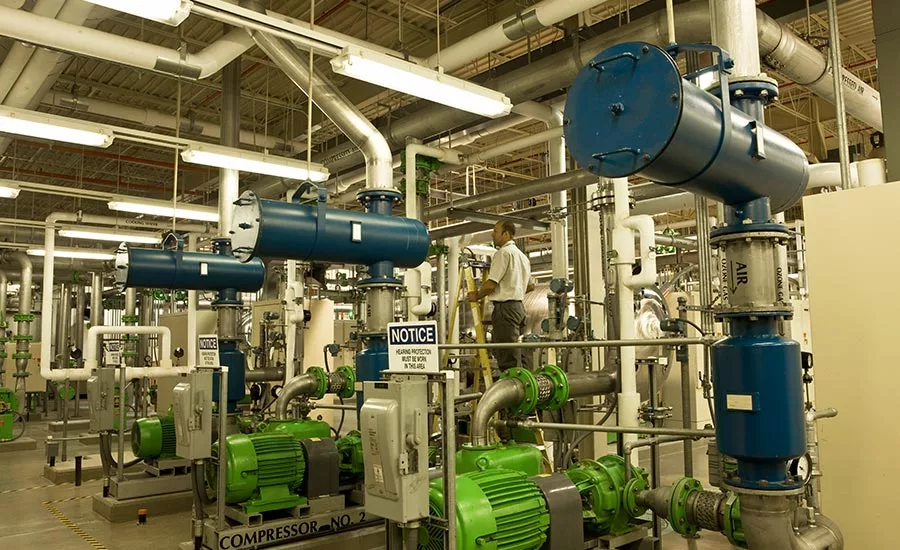How to Prep Compressors for the Hot Summer Months

Summer is finally here. That means no school, family barbeques, picnics and vacations, baseball games, swimming pools and fun in the sun. But, for some food and beverage processors, the hot summer months translates to some not-so-fun challenges with regards to compressors.
Just like any appliance, compressors require regular cleaning and maintenance. Furnaces need a tune-up before the winter hits, and air conditioners need a checkup before the outdoor temperatures begin to rise.
Compressors are no different.
That’s why it’s imperative food and beverage processors prep their compressor for the hot, summer months.
“Facilities rely on their compressed air system for many processes, but it is often forgotten about until it breaks down and production stops,” says Keith Fedor, technical support manager for Kaeser Compressors, Inc., Fredericksburg, Va. “A little preventive maintenance at the change of seasons can save you downtime and headaches later in the season.”
The challenge in the hotter months is how to keep the compressor room cool when the temperatures continue to increase.
Fun in the sun for compressors means condensation, overheating and working harder to produce the same results. When not prepped properly for the hot summer months, compressors tend to work overtime or simply take an “unplanned” vacation.
Here’s a list of Top 10 ways to prepare your compressor for elevated temperatures during the summer months.
- Check the oil. And, change it if need be. Compressors need oil changes, especially in the summer, as excessive heat tends to kill most compressor oils. Changing the oil/fluid on schedule maintains proper viscosity for better lubrication and removes moisture, acids, wear metals and other contaminants.
- Check ventilation. Proper ventilation helps with compressor efficiency and keeping the operating temperature down. Put a thermometer in the compressor room to measure the ambient temperature of the room. If the temperature gets too high (above 100°F), add more fresh, cool air to the room. Properly sized louvers and fans should do the job, but you might need to consider adding duct work to remove exhaust heat from the room.
- Examine the receiver tank. With the additional moisture in the air from the hotter temperatures, if the receiver tank drain isn’t working properly, it could fill up with water instead of storing air. Also, make sure the tank’s pressure gauge and safety relief valve are working, and that the tank isn’t in the path of exhaust flow. Heating up the tank will only re-heat the compressed air, reduce moisture separation and possibly reduce the effectiveness of dryers and filters.
- Check the fluid system. To ensure proper cooling and lubrication and to prevent unscheduled downtime, ensure there are no restrictions in the compressor’s fluid circulation.
- Maintain the water’s pressure, flow, quality and temperature. It’s beneficial to monitor and maintain the pressure, flow, quality and temperature of the water used in the cooler to prevent overheating. Making sure there is not an issue with the cooling water supply in water-cooled compressors will help keep operating temperatures in the appropriate ranges.
- Regularly examine drains. It’s important to clear out blockages or debris to ensure they can handle extra water flow that results from condensation. Make sure all the drains on tanks, dryers and filters are functioning properly. Many have test buttons. Adjust timer settings on timed drains, or if using manual drains, make sure to check it more frequently.
- Check the electrical cabinet. Dirt and dust can form an insulating layer and build up heat on electrical components. Be sure the cabinet fan works, and to clean or replace the filters on the electrical cabinet if present. Use appropriate precautions when cleaning the electrical cabinet.
- Watch for cracks and tears. High heat can result in rips, cracks and tears on the compressor’s belts and couplings.
- Clean out filters. Dirt, dust and debris can clog filters and increase the compressor’s operating temperature. Cleaning filters will keep electrical components running properly and keep the oil cleaner longer.
- Maintain the compressed air treatment equipment (especially the dryer). A majority of air treatment equipment is rated at 100 psig inlet, 100°F inlet temperatures and 100°F ambient temperatures. During hot summer months, an increase in any of these conditions can often act to decrease the capacity of the equipment. Make sure the dryer is getting the coolest air possible, ensure that the condenser is clean and have a certified refrigerant technician connect a set of gauges to verify proper pressures of the refrigerant circuit and to check the refrigerant level.
Don’t wait for rising temperatures to reveal your compressed air problems. Take steps now and avoid costly downtime from stopped production and an expensive emergency service call.
Looking for a reprint of this article?
From high-res PDFs to custom plaques, order your copy today!







